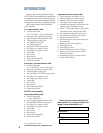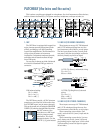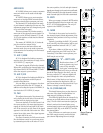
11
TIPSLEEVETIPSLEEVE
9. AUX 1 RETURN INPUTS
Patch the outputs of external parallel ef-
fects devices to these inputs.
Signals coming in are adjusted using the
AUX 1 RETURN (43) fader and MUTE.
When connecting a mono device (just one
cord), always use the left (mono) input and
plug nothing into the right input. The signal
will appear on both sides.
10. AUX 2 RETURN INPUTS
Patch the outputs of external parallel ef-
fects devices to these inputs.
Signals coming in are adjusted using the
AUX 2 RETURN (40) fader and MUTE.
When connecting a mono device (just one
cord), always use the left (mono) input and
plug nothing into the right input. The signal
will appear on both sides.
Note: The AUX 2 RETURN signal is com-
bined with the signal from the internal
effects processor.
11. CD/TAPE INPUT
Patch the outputs of your intermission
entertainment here. Any line-level mono or
stereo device can be used: tape, DVD/CD
player, television audio, etc.
Signals coming into the CD/TAPE (11) in-
puts are adjusted using the CD/TAPE RETURN
(35) fader and MUTE.
Also see page 16 for information regarding
the BREAK (36) switch.
RCA unbalanced wiring:
Tip = hot, sleeve = shield
When connecting a mono device (just one
cord), you’ll need a “Y-splitter” RCA adapter. It
turns a mono output cord into two cords; so
both the left and right tape input jacks can be
used. This adapter is widely available.
Note: There is a chance of feedback if you
have the ins and outs connected to the same
recorder, and it is in record mode.
12. TAPE OUTPUT
Use these jacks to capture the entire perfor-
mance to tape. The signal at these jacks is the
main mix, but it is not affected by the position
of the MAIN MIX (34) faders.
If you find that the output to tape is quite
low in level, but your main speaker sound lev-
els are good, you might try turning down the
100 240 VAC, 50/60 Hz,
30 WATTS
POWER
ON
SLEEVE
TIP
TIPSLEEVE
TIP
SLEEVE
level controls of your amplifiers a little. Adjust
the channel faders upwards to compensate.
This will increase the levels in the mixer and
the tape output.
13. EFX FOOTSWITCH
You can connect a normally-open footswitch
here to switch the EMAC effects processor in
and out. Closing the switch connection causes
the internal effects to be bypassed, as you bask
in the warm glow of the BYPASS LED (44).
Note: This only affects the internal effects
and does not affect any signals from devices
plugged into AUX 1 and AUX 2 returns.
1/4" TS (Tip-Sleeve) Footswitch wiring:
Tip = one end of a normally-open switch
Sleeve = shield, and other end of a
normally-open switch.
14. AC POWER INPUT
This IEC socket
on the rear panel,
is where you con-
nect the supplied
AC linecord to pro-
vide AC power to
the mixer. Plug
the cord into a
suitable AC outlet,
properly grounded
and capable of de-
livering adequate
current.
The mixer has a universal-input, switching
power supply, so you can plug the AC linecord
into any AC outlet with a nominal voltage
between 100 and 240 VAC, without having to
worry about setting any switches or using a
step-up or step-down voltage transformer.
15. POWER SWITCH
Push the side of the switch labeled “ON” to
turn the mixer on; you should see the POWER
LED (30) glow in confirmation on the top
right of the mixer. To turn the mixer off, push
the switch the other way.
As a general rule, turn the mixer on first,
before any amplifiers or powered speakers,
and at the end of a show, turn it off last. This
will prevent any turn-on or turn-off thumps
being heard in your speakers.


















